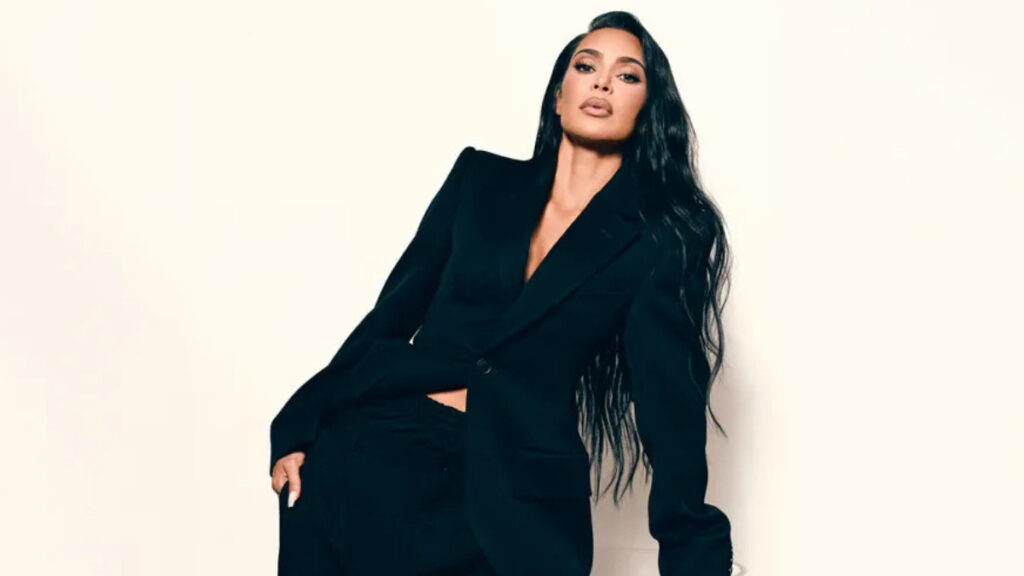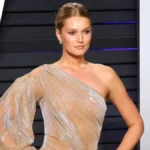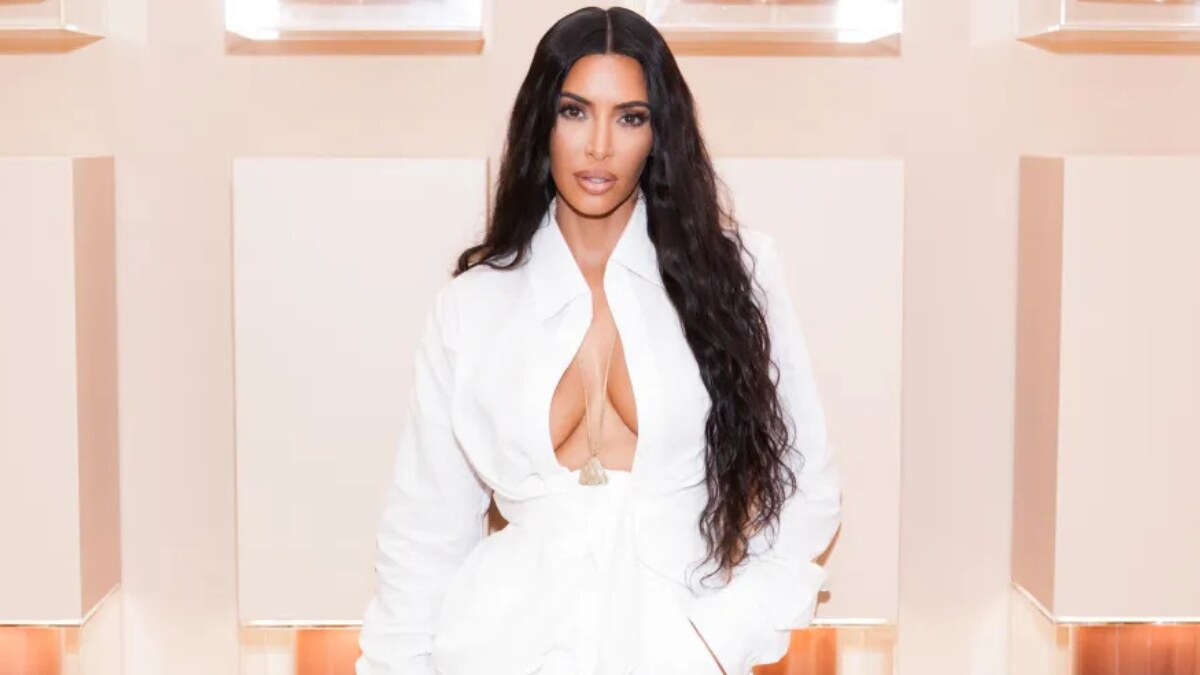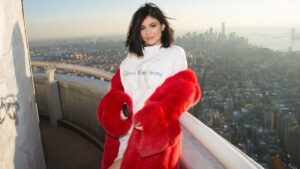Beneath the soft hum of climate control, the door swings open to reveal a world few have ever seen — Kim Kardashian’s private vault. Here, sequined gowns glimmer like captured starlight, their delicate threads holding whispers of the red carpets of the past. A shelf lined with Polaroids, after-party wristbands, and backstage passes feels like a pop culture time capsule. The air carries the faint scent of preserved silk and leather, a fragrance that only decades of couture can create.
This is more than a wardrobe. It’s a living museum of celebrity fashion history, where every hanger holds an iconic pop culture moment and every box hides an untold story. Some pieces are instantly recognizable — the sculpted gowns that went viral, the sleek streetwear that redefined casual luxury. Others have never been photographed, existing only in this curated archive.
The Kim Kardashian archive isn’t just about clothes; it’s about reinvention, influence, and the cultural shifts they sparked. What stories lie in the folds of these fabrics? Which moments shaped an era — and which ones are still waiting to be revealed? Step inside, and the answers begin to unfold.
From Calabasas Closets to a Cultural Capital
Before the world knew her as a billionaire mogul and cultural force, Kim Kardashian was navigating the glossy yet precarious world of early 2000s celebrity style. In the Paris Hilton era, she appeared in paparazzi shots as the stylish best friend — always polished, always coordinated, and already attuned to the quiet power of image. Her Calabasas closet, while enviable, wasn’t stocked with unlimited couture; instead, it was a carefully curated mix of borrowed designer pieces, gifted items, and early splurges that hinted at her fashion ambitions.
Working closely with stylist Monica Rose, Kim learned how to craft a consistent visual identity — the body-conscious silhouettes, oversized sunglasses, and neutral palettes that would become part of her signature. But what set her apart wasn’t just the clothes; it was how she used them. Long before Instagram turned every outfit into content, Kim was leveraging paparazzi coverage as a runway. She understood that candid street style could build a personal brand as effectively as any red carpet.
As Keeping Up With the Kardashians took off, her reality TV wardrobe evolved from aspirational mall chic to runway-ready ensembles. Each season brought bolder fashion risks, subtly syncing with the rise of social media platforms where every post was a calculated style statement. By blending accessibility with aspiration, Kim transformed from a participant in celebrity fashion trends to a driver of them — laying the foundation for the cultural archetype she would become: a woman whose wardrobe choices shape, and sometimes define, the era.
Decoding the Power Looks: Garments That Became Headlines
The “Met Gala Armor” Years
At the Met Gala, Kim Kardashian’s appearances have become less about mere aesthetics and more about deploying what could be called “fashion armor.” Each year she attends, her gown functions as a strategic statement — both a nod to the event’s theme and a calculated moment in her narrative. In 2019, her Thierry Mugler “wet look” dress blurred the line between surrealist art and sensual fantasy, sparking debates about body modification, impossible silhouettes, and the spectacle of celebrity red carpet statements.
Her 2021 “shadow silhouette” — a head-to-toe Balenciaga blackout — stripped away the face entirely, forcing the conversation toward anonymity, identity, and meme culture. It was as much a provocation as an outfit, drawing split reactions: brilliance to some, a publicity stunt to others.
Through these choices, Kim has weaponized the Met Gala as a platform for self-reinvention, understanding that in the world of Met Gala fashion analysis, the look is never just a look. It’s a headline, a cultural provocation, and a piece of personal mythology.
Streetwear as Status Symbol
In the mid-2010s, Kim Kardashian began rewriting the rules of casual wear. Trading in embellished gowns for oversized hoodies, body-hugging leggings, and monochrome palettes, her Yeezy streetwear era turned the everyday sidewalk into a curated runway. These weren’t lazy off-duty choices — they were deliberate, styled down to the last tonal sneaker, embodying the emerging luxury athleisure trendsetter’s movement.
Paparazzi photos from Calabasas coffee runs and New York hotel exits became unofficial campaigns, blurring the boundary between personal life and brand promotion. Her minimal, utilitarian silhouettes mirrored high fashion’s shift toward comfort-driven design, while still carrying the weight of exclusivity through limited-edition drops and insider-only access.
As a result, Kim’s celebrity streetwear influence extended beyond fans to the fashion industry itself, prompting luxury houses to embrace sweatshirts, biker shorts, and track pants as legitimate runway fare. She transformed streetwear from subculture to status symbol — proof that style power doesn’t always require sequins or red carpets.
The Vault’s Secrets: Never-Before-Seen Pieces and Stories
Behind the locked doors of Kim Kardashian’s archive lies a quieter, more secretive history — one made up of pieces the public has never seen. Rows of unworn celebrity couture hang in garment bags, each tagged with cryptic notes: “Met Gala alt.,” “Press tour option,” “Private dinner.” These are the outfits that almost happened, ghost appearances in her fashion story.
A custom Balmain gown, hand-beaded over 200 hours, was reportedly abandoned minutes before a major event when Kim decided the mood called for something more understated. A jewel-toned Versace slip, tailored to perfection, was swapped out for a neutral-toned alternative to fit an evolving brand aesthetic. In some cases, the decision wasn’t even hers — event politics, designer negotiations, or last-minute sponsorship changes dictated the outcome.
Stylists speak about these behind-the-scenes fashion stories with a mix of awe and frustration, aware that some of the most exquisite pieces in her collection may never see a flashbulb. Fashion archivists, on the other hand, see them as priceless — untouched relics that preserve the artistry and intent of a moment frozen in time.
Walking through this section of the vault feels almost conspiratorial, as if you’ve stumbled into a parallel fashion universe. Each unworn gown carries a “what if” energy, a reminder that for every outfit that dominates headlines, there are others — equally breathtaking — that remain hidden, their stories locked away, waiting for the day Kim decides the world is ready to see them.
Cultural Earthquakes: Outfits That Shifted Conversations
The 2014 Paper Magazine Cover Dress
When Paper Magazine released Kim Kardashian’s 2014 “Break the Internet” cover, the world saw her nude from the waist up, balancing a champagne glass on her backside — but few realized there was also a “non-dress” element to the shoot. While the now-iconic viral celebrity image captured in a black latex gown for the same spread was overshadowed by the topless shot, it carried its pop culture fashion controversy.
The dress, custom-made to mimic liquid night, clung to her figure in a way that blurred sculpture and seduction. Styled by Jean Paul Gaultier, it spoke to fashion’s love affair with exaggeration, performance, and camp. Yet, in the context of the shoot, it became part of a larger statement on spectacle and self-curation.
Public reaction was predictably split — some hailed it as art, others dismissed it as attention-seeking. But in fashion history, it marked a moment where clothing (and intentional lack thereof) became inseparable from digital virality, forever fusing couture with clickbait culture.
The 2021 Met Gala “Shadow Silhouette”
At the 2021 Met Gala, Kim Kardashian arrived in what could only be described as the ultimate exercise in fashion anonymity — a head-to-toe black Balenciaga ensemble that obscured her face, hair, and even her silhouette. In a sea of glittering gowns and elaborate headpieces, her absence of visible identity became the loudest statement of the night.
The look sparked an instant cultural frenzy: memes flooded social media, likening her to a shadow, a glitch in the Matrix, even a red-carpet ghost. Fashion think pieces debated whether it was an act of self-erasure, a commentary on celebrity overexposure, or simply a brilliant publicity move.
By removing her face from the equation, Kim forced attention onto the shape, texture, and concept of the outfit itself — and onto the idea that presence doesn’t require visibility. It was a reminder that in the right hands, anonymity can be as provocative and memorable as the most intricate couture.
Kim Kardashian and the Celebrity Fashion Pantheon
In the celebrity fashion pantheon, Kim Kardashian stands shoulder to shoulder with industry-defining figures — yet her approach to style and branding is distinctly her own. Beyoncé’s fashion evolution is a masterclass in control; she curates her image with precision, often revealing looks only after the event. Rihanna, the ultimate fashion risk-taker, thrives on unpredictability, shifting from haute couture to streetwear with effortless authority. Victoria Beckham’s transformation from pop star to respected designer shows the longevity of strategic reinvention.
Kim’s celebrity style evolution, however, merges elements from all three. Like Beyoncé, she understands the power of image control, but she operates in real time, allowing the public to witness — and participate in — her style shifts via social media. Like Rihanna, she’s not afraid of polarizing fashion moments, but her risks are often tied to calculated branding opportunities. And like Victoria Beckham, she leverages her fashion choices as extensions of her business ventures, from shapewear to fragrance lines.
Fashion branding strategies differ among them, but Kim’s is uniquely hybrid: high-access visibility mixed with high-gloss exclusivity. As fashion critic Vanessa Friedman once observed, “Kim doesn’t just wear the dress — she engineers the moment.”
In this context, the Kim Kardashian archive is more than personal memorabilia; it’s a living portfolio of market-savvy style moves. Her place in the celebrity fashion pantheon is secured not just by what she wears, but by how those choices ripple across industries — from luxury fashion houses to fast-fashion racks around the globe.
“The Day I Walked Into the Vault”
The first thing I noticed was the temperature — cool enough to make me pull my blazer tighter, the kind of climate that whispers preservation. As the door eased open, a faint scent of preserved silk and polished leather drifted toward me, an aroma that felt both luxurious and ancient.
Racks stretched in perfect symmetry, each garment sheathed in a translucent cover, their silhouettes hinting at the treasures beneath. A beadwork gown caught the light like frozen rain, while a row of monochrome bodycon dresses stood like sentinels of an era. In the corner, a stack of archival boxes bore handwritten labels: Met Gala ‘13 Alt, Paris Couture, Private Dinner.
Kim’s presence was felt in every detail — the symmetry of the hangers, the careful spacing between garments, the way a single pair of embellished heels rested on its pedestal. It wasn’t just a closet; it was a gallery, curated with the precision of a museum and the intimacy of a diary.
As I walked deeper, I felt the weight of the stories sewn into each seam. These weren’t just outfits. They were cultural timestamps, moments that had shaped — and sometimes shocked — the world outside these walls. In that quiet, I realized I wasn’t just looking at clothes. I was looking at history, stitched in sequins and silk.
Behind the Seams: Preservation, Archiving, and Fashion’s Future
Archiving a celebrity wardrobe on the scale of Kim Kardashian’s is as much science as it is style. Her collection is stored under strict climate control — a steady 65°F with humidity levels kept under 50% to prevent fabric degradation. Each garment is housed in breathable cotton garment bags, free from acidic materials that could yellow silk or weaken delicate lace. Shoes and accessories rest in custom archival boxes, cushioned with acid-free tissue to preserve shape and texture.

Digital cataloging is equally meticulous. Every piece in the celebrity wardrobe archiving system is photographed in high resolution, tagged with metadata detailing designer, event, alterations, and even the cultural context of its debut. According to fashion preservation techniques used by institutions like the Metropolitan Museum of Art’s Costume Institute, such records are crucial for both provenance and future exhibition planning.
Textile conservators note that celebrity garments present unique challenges: heavy beading can strain fabric over time, and bold dyes risk fading under light. “You’re not just saving a dress,” explains one museum curator, “you’re preserving the story it tells.”
In Kim’s vault, preservation isn’t just about safeguarding fabric. It’s about maintaining a living archive — one that ensures each iconic look remains as vibrant and culturally resonant decades from now as the day it first turned heads.
Kim Kardashian’s Vault in the Digital Age
In the digital era, the idea of a “vault” no longer has to be confined to a temperature-controlled room — it can exist in pixels, code, and the cloud. Kim Kardashian’s vault could one day expand into a digital fashion archive, where her most iconic looks are scanned in 3D and preserved for virtual viewing. Imagine fans exploring her Met Gala gowns in augmented reality, rotating the image to see every bead and seam up close, or attending a metaverse couture show where AI models wear her past outfits in new, reimagined ways.
The possibilities stretch beyond entertainment. Exclusive NFT drops tied to significant fashion moments could give collectors authenticated digital ownership, while limited AR filters could allow fans to “try on” her most famous looks from their phones.
For Kim, whose career thrives on blending accessibility with exclusivity, this shift could cement her influence in an entirely new medium. Just as she once mastered the jump from reality TV to high fashion, she could bridge the gap between celebrity style history and interactive digital culture. In doing so, her archive wouldn’t just preserve the past — it would actively shape how fashion is experienced in the future.
The Wardrobe as a Living Legacy
Kim Kardashian’s vault is more than a repository of garments — it’s a living narrative stitched from moments that have shaped both her life and the cultural landscape. Each dress, heel, and accessory is a fragment of a larger story: of calculated reinventions, seismic pop culture shifts, and the merging of personal identity with public spectacle. In its quiet, climate-controlled stillness, the vault holds the noise of countless flashbulbs, the hum of red carpets, and the ripple of debates sparked online.
It is, in essence, a time capsule that refuses to remain static. As new chapters are added — whether in silk, latex, or pixels — the archive becomes both a record of the past and a blueprint for how influence can be worn, displayed, and reimagined.
Standing at the threshold of that vault, one can’t help but wonder: what would our archives hold? Not in gowns or couture, perhaps, but in keepsakes, photographs, or worn-in jackets that recall turning points in our own lives. In the end, Kim’s vault reminds us that style is memory made visible — and that every era, no matter how fleeting, deserves to be preserved.
Mohit Wagh is the co-founder of The Graval with over 10 years of experience in SEO and content strategy. He specializes in crafting data-driven, authoritative content that blends cultural insight with digital growth.















5 thoughts on “Inside Kim Kardashian’s Vault: Untold Stories, Iconic Outfits, and Cultural Moments That Shaped an Era”